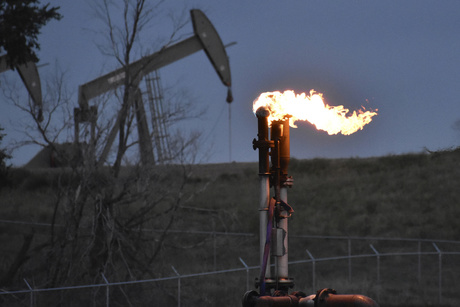US energy industry methane emissions are triple what government thinks

American oil and natural gas wells, pipelines and compressors are spewing three times the amount of the potent heat-trapping gas methane as the government thinks, causing $9.3 billion in yearly climate damage, a new comprehensive study calculates.
But because more than half of these methane emissions are coming from a tiny number of oil and gas sites, 1% or less, this means the problem is both worse than the government thought but also fairly fixable, said the lead author of a study in Wednesday's journal Nature.
The same issue is happening globally. Large methane emissions events around the world detected by satellites grew 50% in 2023 compared to 2022 with more than 5 million metric tons spotted in major fossil fuel leaks, the International Energy Agency reported Wednesday in their Global Methane Tracker 2024. World methane emissions rose slightly in 2023 to 120 million metric tons, the report said.
"This is really an opportunity to cut emissions quite rapidly with targeted efforts at these highest emitting sites," said lead author Evan Sherwin, an energy and policy analyst at the U.S. Department of Energy's Lawrence Berkeley National Lab who wrote the study while at Stanford University. "If we can get this roughly 1% of sites under control, then we're halfway there because that's about half of the emissions in most cases."
Sherwin said the fugitive emissions come throughout the oil and gas production and delivery system, starting with gas flaring. That's when firms release natural gas to the air or burn it instead of capturing the gas that comes out of energy extraction. There's also substantial leaks throughout the rest of the system, including tanks, compressors and pipelines, he said.
"It's actually straightforward to fix," Sherwin said.
In general about 3% of the U.S. gas produced goes wasted into the air, compared to the Environmental Protection Agency figures of 1%, the study found. Sherwin said that's a substantial amount, about 6.2 million tons per hour in leaks measured over the daytime. It could be lower at night, but they don't have those measurements.
The study gets that figure using one million anonymized measurements from airplanes that flew over 52% of American oil wells and 29% of gas production and delivery system sites over a decade. Sherwin said the 3% leak figure is the average for the six regions they looked at and they did not calculate a national average.
Methane over a two-decade period traps about 80 times more heat than carbon dioxide, but only lasts in the atmosphere for about a decade instead of hundreds of years like carbon dioxide, according to the EPA.
About 30% of the world's warming since pre-industrial times comes from methane emissions, said IEA energy supply unit head Christophe McGlade. The United States is the No. 1 oil and gas production methane emitter, with China polluting even more methane from coal, he said.
Last December, the Biden administration issued a new rule forcing the U.S. oil and natural gas industry to cut its methane emissions. At the same time at the United Nations climate negotiations in Dubai, 50 oil companies around the world pledged to reach near zero methane emissions and end routine flaring in operations by 2030. That Dubai agreement would trim about one-tenth of a degree Celsius, nearly two-tenths of a degree Fahrenheit, from future warming, a prominent climate scientist told The Associated Press.
Monitoring methane from above, instead of at the sites or relying on company estimates, is a growing trend. Earlier this month the market-based Environmental Defense Fund and others launched MethaneSAT into orbit. For energy companies, the lost methane is valuable with Sherwin's study estimate it is worth about $1 billion a year.
About 40% of the global methane emissions from oil, gas and coal could have been avoided at no extra cost, which is "a massive missed opportunity," IEA's McGlade said. The IEA report said if countries do what they promised in Dubai they could cut half of the global methane pollution by 2030, but actions put in place so far only would trim 20% instead, "a very large gap between emissions and actions," McGlade said.
"It is critical to reduce methane emissions if the world is to meet climate targets," said Cornell University methane researcher Robert Horwath, who wasn't part of Sherwin's study.
"Their analysis makes sense and is the most comprehensive study by far out there on the topic," said Howarth, who is updating figures in a forthcoming study to incorporate the new data.
The overflight data shows the biggest leaks are in the Permian basin of Texas and New Mexico.
"It's a region of rapid growth, primarily driven by oil production," Sherwin said. "So when the drilling happens, both oil and gas comes out, but the main thing that the companies want to sell in most cases was the oil. And there wasn't enough pipeline capacity to take the gas away" so it spewed into the air instead.
Contrast that with tiny leak rates found in drilling in the Denver region and the Pennsylvania area. Denver leaks are so low because of local strictly enforced regulations and Pennsylvania is more gas-oriented, Sherwin said.
This shows a real problem with what National Oceanic and Atmospheric Association methane-monitoring scientist Gabrielle Petron calls "super-emitters."
"Reliably detecting and fixing super-emitters is a low hanging fruit to reduce real life greenhouse gas emissions," Petron, who wasn't part of Sherwin's study, said. "This is very important because these super-emitter emissions are ignored by most 'official' accounting."
Stanford University climate scientist Rob Jackson, who also wasn't part of the study, said, "a few facilities are poisoning the air for everyone."
"For more than a decade, we've been showing that the industry emits far more methane than they or government agencies admit," Jackson said. "This study is capstone evidence. And yet nothing changes."



